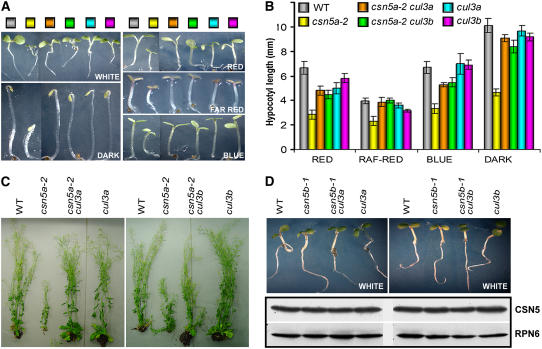Figure 9.
CUL3A or CUL3B Loss of Function Results in the Suppression of the Pleiotropic Developmental Defects of the csn5a-2 Mutant.
(A) and (B) Genetic interaction between CSN5 and CUL3. Phenotypes (A) and hypocotyl elongation (B) of 5-d-old wild-type, csn5a-2, cul3a, and cul3b single and double mutant seedlings grown in darkness or in different light qualities, as indicated (see Methods). Values shown represent means of 25 seedlings ± sd. The colored boxes shown in (A) correspond to the genotypes indicated in (B).
(C) Loss of CUL3A or CUL3B suppresses csn5a developmental defects at all stages. Phenotypes of 8-week-old wild-type, csn5a-2, and cul3a single and double mutant plants (left) or wild-type, csn5a-2, and cul3b single and double mutant plants (right), as indicated, grown in long-day conditions.
(D) Top panels, phenotypes of 4-d-old wild-type, csn5b-1, and cul3a single and double mutant plants (left) or wild-type, csn5b-1, and cul3b single and double mutant plants (right) grown for 4 d in white light. Bottom panels, detection of CSN5 proteins from wild-type, csn5b-1, cul3a, and cul3b single and double mutant plants, as indicated. Total protein extracts from 6-d-old white light–grown seedlings were subjected to SDS-PAGE and immunoblot analyses with anti (α)-CSN5 polyclonal antibodies. Equal protein loading was confirmed using α-RPN6 antibody.

